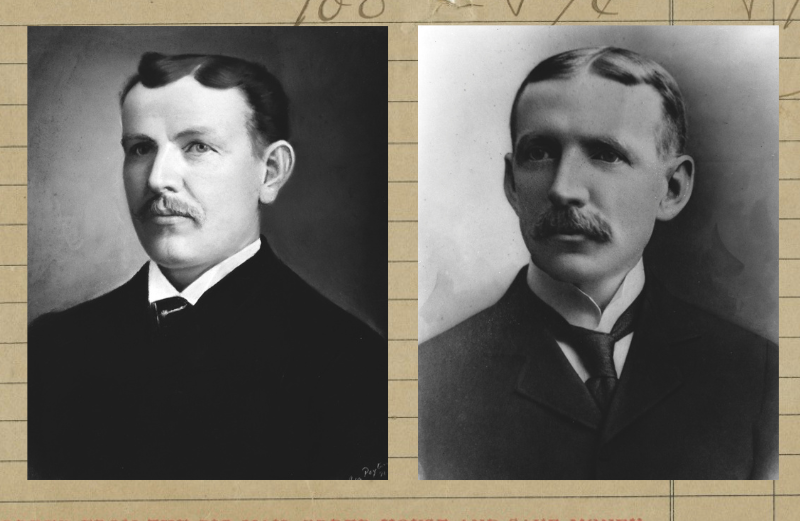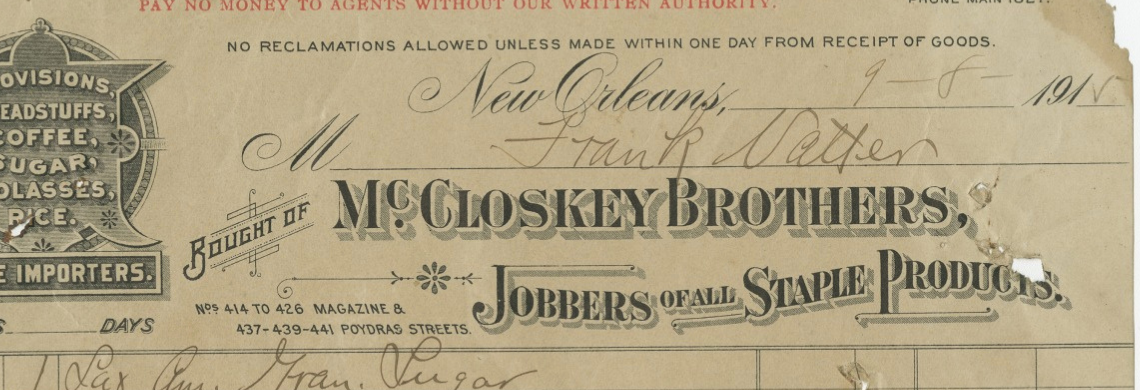The Hugh McCloskey papers were donated to THNOC in 2009 by the family of Corinne McCloskey Maunsell, who was Hugh’s daughter. They include a trove of photographs that provide a richer sense of the culture and beauty of New Orleans at the turn of the century. They also shed light on the journeys of three Irish brothers who made new lives for themselves in the Crescent City.

Brothers Hugh (left) and Patrick McCloskey. (THNOC, 1979.325.4236; 1979.325.4235)
From Londonderry to Louisiana
In the late 19th century several brothers of the McCloskey family emigrated from Dungiven, County Londonderry, in present-day Northern Ireland, to New Orleans. They were following their uncle, who arrived in the United States in 1837 and settled in New Orleans in 1838. The McCloskey siblings—Hugh (1853–1927), Patrick (1858–1906), and Bernard (1860–1942)—rose to prominence in New Orleans. Between 1871 and 1942 they were active in the business community and civic activities. The brothers helped establish some of the most iconic institutions of turn-of-the-century New Orleans, including the business reorganization that would become D. H. Holmes Company Ltd., whose landmark Canal Street department store would go on to become the largest in the South. Hugh co-founded the Hibernia Bank and Trust Company, and the brothers also played a role in constructing the Hibernia Bank Building, the tallest building in Louisiana at the time and still a familiar part of the city’s skyline. They were also present at the cornerstone laying of the Louisiana Supreme Court building on Royal Street.
The Hugh McCloskey papers include photos spanning multiple decades. These images—many of them documenting distinctive and curious public events—reveal a fascinating web of the brothers’ interconnected efforts to promote the success and progress of the city while also enjoying the benefits of business opportunities and social life here.
A ship and civic pride
People of New Orleans present a silver bell and silver service to the cruiser USS New Orleans, May 24, 1899, (THNOC, MSS 980.22, MSS 980.23)
When the Spanish-American War broke out in 1898, the US Navy sought to increase its capabilities with the purchase of a new English-built cruiser that had originally been contracted for the Brazilian Navy. On March 18, 1898, the ship was commissioned as the USS New Orleans, keeping with naval custom of naming cruisers after cities. The people of New Orleans, filled with civic pride and a patriotic wartime spirit, immediately began planning to fulfill another custom: providing the warship with an appropriate ceremonial silver service. Patrick McCloskey was a member of one of the committees arranging the gifts, and the McCloskey Brothers firm made a monetary contribution. A sterling silver punch bowl gifted to the ship was reported to be the largest made in the United States at that time, holding 6 1/4 gallons.
Swords on Saint Charles
Mayor Martin Behrman and officers of the U.S. Public Health and Marine Hospital Service at City Hall, October 28, 1905. (THNOC, MSS 980.32)
In 1905, President Theodore Roosevelt ordered the then-largest deployment of commissioned officers of the US Public Health and Marine Hospital Service to combat a yellow fever outbreak in New Orleans. Locals expressed their gratitude and celebrated the end of the outbreak with—of course—a parade. Twenty-five doctors gathered at the St. Charles Hotel wearing their full dress uniforms, swords and all. After a formal reception with Gov. Newton C. Blanchard, the doctors paraded to another formal reception with Mayor Martin Behrman and other civic leaders in city hall. Bernard McCloskey appears among the civic leaders present that day, seated on the far-right side of the picture.
Patron (saint) party
More black tie than green beer, the lavish formal event shown in this photograph illustrates the success of some Irish Americans in New Orleans. (THNOC, MSS 980.27)
Irish immigrants first arrived in New Orleans in the 18th century. A hundred years later, New Orleans had a larger Irish population than any other city in the South. St. Patrick’s Day festivities are obvious examples of the cultural enrichment that they brought to the city. In 1909 Hugh McCloskey, pictured third from the left at the head of the table, and other Irish American businessmen celebrated their Hibernian heritage with a formal banquet at the St. Charles Hotel. Bernard McCloskey was toastmaster for the event. Several men gave speeches, with subjects including their hopes for Ireland’s independence and their appreciation for newfound freedoms and opportunities in the US. Hugh McCloskey spoke about the achievements of the Irish in New Orleans.
Alluring lights
Electrical illumination of D. H. Holmes Co., Ltd., on Mardi Gras in 1911. (MSS 980.46)
Seen here in a 1911 publicity photo, this giant spider on a web of lights on the D. H. Holmes building was not merely a Carnival decoration, but would have been a stunning spectacle to the 84 percent of Americans who did not yet have electricity in their homes. The photo was meant to convey to other parts of the country that New Orleans is warm in the winter and has the whimsical fun of Mardi Gras.
In addition to being a member of the board of D. H. Holmes, Hugh McCloskey was president of New Orleans Railway and Light Company, which sponsored the photographs. By this time, public streetcars were the biggest consumers of electricity in New Orleans, a modern luxury that city leaders hoped would position New Orleans as a progressive city worthy of business and tourist interests. Hugh likely would have seen this photograph and others taken of illuminations along the downtown parade routes as opportunities to showcase the city's electric infrastructure and, by doing so, expand his own business.












